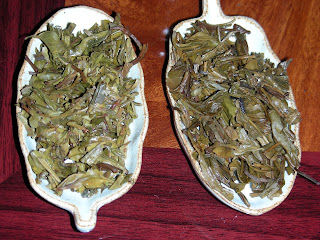Names of Phoenix Dan Cong are as complicated and unsystematic as it can be. Only in the last 50+ years, the communist party put some order to it, however it's intended to organize and expand the commercial market. Names of old trees remained lack of system. Top 10 fragrance
DCs were registered then, namely:
Yu Lan Xiang - magnolia flower fragrance 玉蘭香
Huang
Zhi Xiang - orange flower fragrance 黄枝香
Xing Ren Xiang - Almond flavor 杏仁香
Zhi Lan Xiang - Orchid fragrance 芝蘭香
Mi4
Lan Xiang - Honey Orchid fragrance 蜜蘭香
Gui
Hua Xiang -
Osmanthus fragrance 桂花香
You
Hua Xiang -
Pomelo/grapefruit flower fragrance 柚花香
Jiang Hua Xiang - Ginger flower fragrance 姜花香
Rou Gui
Xiang - Cinnamon flavor (not the same as
Wuyi Rou Gui) 肉桂香
Mi3
Lan Xiang - Milan flower fragrance
米蘭香
- tinny grain size yellow flowering plant from the southern provinces of China)These are signature well known fragrance types of Phoenix teas, also used as commercial product names for clones. For old trees, although they have the same fragrance, most of them are named individually. Many trees have similar fragrance but not entirely the same. Clones of such trees are group together under the same fragrance type tea.
Zhi Lan Xiang for example, there are 2 mother trees, 2 out the top 4 mother trees on WU Dong Mountain. Late
Ching dynasty, a tea farmer cloned some branches from the 2 trees, planted them around Phoenix mountain, 8 of the cloned survived and still living today, the 8 locations simulate 8 deities crossing the sea, hence these cloned trees are now called Ba Xian
Guo Hai (short for Ba Xian).
There are 40+ varietals that can produce the flavor of Huang
Zhi Xiang,
Ao Fu Hou is one of the mother trees out of the 40. Each village named their own HZX or any varietal for that mater after their village names or mountain name. ie Wu Dong HZX, Shi Tou HZX. There are Qing Xiang - light fragrance varietals, also Nong Xiang - intense fragrance varietals. Huang
Zhi Xiang is the largest production of the top 10 fragrance.
Names of Phoenix tea can be roughly separated into 3 concepts, commercial products, old tree names, and finishing product names of old trees.
Names of old bushes can be anything you can imagine. These names do not change much. Thief Shit, Duck Shit, Old Duck, Big Dark Leaf, Song
Zhong, Song
Zhong Jai (Next generation Song Zhong),
Jiang Mu
Xiang (Ginger Mom), Red Lady Umbrella, Dong Fang
Hong (Same as Song Zhong, changed to DFH for Chairman Mao), etc.. just to name a few out of many many old trees. It can be named by shape of leaves, color of leaves, location of tree, shape of tree, mythes, historic events, etc. Just about anything you want to name it after, not logical, not scientific, not systematic.
The term Song Zhong is still confusing to me. I know an old bush is named Song Zhong, its descendants are also named beginning with Song Zhong, such as Song Zhong Jai, or Song Zhong Jiang Hua Xiang. Also it can be used as an over all varietal for Phoenix tea because it was discovered in Song dynasty. Some people say only trees still alive from Song is considered as Song Zhong.
Finished teas from old trees are name differently base on quality. When fresh leaves from the same tree were divided into 2 productions, one might be better in quality than the other, therefore there will be 2 names for the batches from the same tree. For example, Po
Tou and Po
Tou Hao, they are both from the same trees in separate batches, Po
Tou Hao is better in quality than Po
Tou, if you don't already know what
Hao means in Chinese,
Hao means good. Not too scientific but does the job in distinguishing the 2 batches. The reason for different productions (all spring harvest) is early and later harvest, separated only by days.
Many of the names are local
Chao Zhou dialects and
slangs which makes it hard to understand even for Chinese of other parts of China. This is a disadvantage for Phoenix Dan Cong. Small production, intense labor, confusing names made marketing DC difficult. True Dan
Congs are hidden gems by all means, both in Chinese market and across seas.
Quality of finishing DC tea is a god willing decision. No man can control the out come, not even the best tea masters! It takes good trees, good weather and good skills to make good tea. Only 2/3 of the old trees were made well each year, mainly due to rainy weather. And not one tree can make excellent tea every year. Same tree can sell for two even three times more in different years base on the quality of that year.
In order to know Phoenix tea well, it's a lengthy challenge. The locals say it takes 3 years to learn how to drink DC as a consumer. First to learn is the seasonal flavor, then the mountain flavor, then elevation, then fragrance, then old trees, then as many old trees as you can, eventually the best production of the best tree of the year which is probably not obtainable even if you had money. The highest price DC of 2007 is $6000+ per 500 g,
mao cha only - straight from the farmer. Yes, it's
USD.
As a tea merchant, there are so much more to learn than how to drink a Dan Cong tea. Identifying a tea by dry leaves, color of tea, wet leaves, what gives floral aroma, what gives honey flavor, what season is it, blended or not, how well is the fermentation, etc etc... It's over whelming but extremely interesting.












